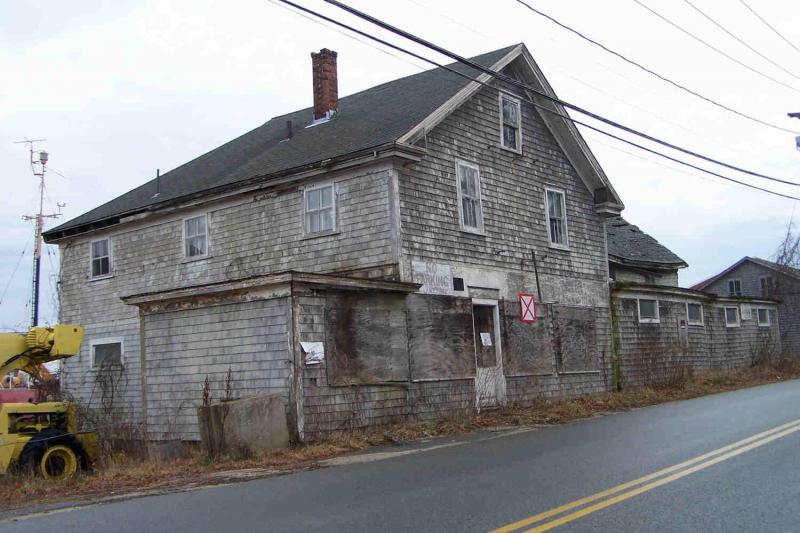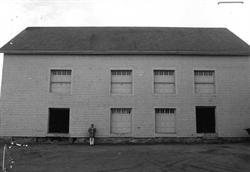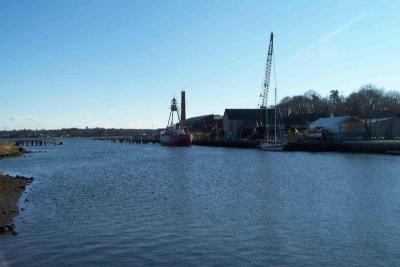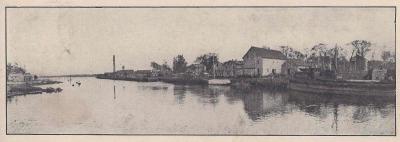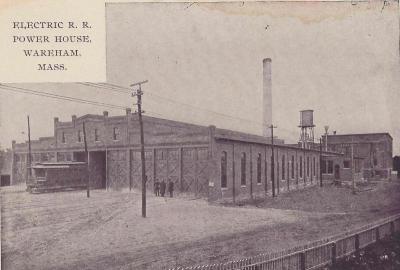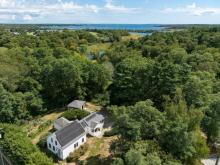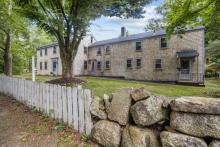A lumberyard, a railroad, a look at the Wareham Narrows Historic District
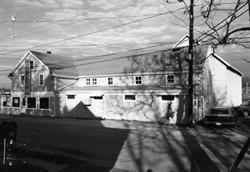
Driving by the derelict gray wooden structures wedged between Besse Park and British Landing is like looking through a dusty window into the past. It makes you want to rub away the years and peer through to a time when Wareham was a bustling waterfront boomtown.
This section of Main Street is like much of the Wareham Narrows Historic District—part gussied up redevelopment, part forlorn relic of the past. The British Landing Condominiums building to the south was originally the New Bedford-Onset Electric Railroad Power House building from the mid-19th century to the early 20th century. Besse Park at the corner of Main and Sandwich Road was a “wharf lot” owned by Tremont Nail Company of Parker Mills Village located further up the Wareham River in 1851. Because the river was too shallow for boat traffic north of the Narrows, many businesses had wharf lots located on the quay to the south.
The gray buildings at 57-59 Main Street sport a sign for Wareham Steamship Company, but that recent use of the site does not give any indication of the important role the property played in Wareham’s mercantile history.
Two of the five buildings on the site are on the Massachusetts Historical Commission’s (MHC) register of historic places for their significance to the Wareham Narrows Historic district as representative of the mercantile economy of the mid-1800s. One, the Granary, was built sometime between 1820 to 1840 at the Tremont Nail Company site and moved to its current location sometime after 1938, according to the MHC records. The other, a retail store, was built by Joshua Tobey, from one of Wareham’s founding families and the donor of the Tobey Hospital property. It became the E.K. Greer Lumber Company store sometime after 1891.
An 1879 map of the “Village of Wareham Narrows” shows the quay as a series of six wharf lots owned by Tremont Co., Agawam Mills, Tobey Mills, Parker Mills, and William H. Collin. J.B. Tobey was Joshua Tobey, who ran a store at the site and later donated the Tobey Homestead to create the Tobey Hospital.
In 1891, Edwin Knowlton Greer, son of Charles K. Greer and Hattie A. (Morse) Greer, purchased Collin’s and the Parker Mill’s wharf lots and established a lumberyard on the property in a single building adjacent to the New Bedford-Onset Electric Railroad.
For the first thirty years, lumber came in from Maine and Canada on three-masted schooners and docked at the quay. With the opening of the Western U.S. forests for timbering in the 1920s, lumber was transported by rail and freight, and water transport took a back seat.
According to Plymouth County Registry records, Greer purchased additional property to the north from James Hurley in 1927. With it, his holdings included the Joshua Tobey store that he was using for the lumberyard, the Tisdale property, and other property of Tobey. The Tobey store had gained a second floor, and an addition to the rear for additional storage, according to MHC records.
A 1952 newspaper article refers to Edwin’s father, Charles K. Greer, as a carpenter and builder from Maine who settled in Wareham in the mid-1800s. The Wareham Cooperative Bank was one of Charles Greer’s accomplishments.
Edwin was born in 1869, one of four children of Charles K. Greer and Hattie A. (Morse) Greer. Another son, Charles K., died in 1872 before he was two years old. In 1896, Edwin married Maria Ethel Howes of “Dennis Port”, MA. The E.K. Greer Company bought out the Tobey lumberyard, shown on the 1879 map, and became the main source of lumber and hardware in the area.
Upon his death at age 61 in 1935, Edwin left all of his property and the E.K. Greer Company to his wife Maria Ethel Greer. According to her obituary in 1966, she then became president and treasurer of E. K. Greer Company.
By then, Edwin owned the lumberyard property as well as eleven other properties that he had acquired between 1923 and 1932. According to a 1935 deed, Ethel, as she preferred to be called, immediately transferred these into the E.K. Greer Company name. Included was deeded land from William E.C. Warr, Louise Barrett, Jessie Bowman, Edwin’s step-mother Lucy P. (Gibbs Morse) Greer, Henry A. Brown Corporation, Preston S. Lincoln, the Onset Board of Trade, and Eldora E. Atwood.
The Henry A. Brown Corporation property was part of the Parkwood Beach subdivision. The Atwood property was in Pinehurst. Later deeds show these properties being transferred to tenants in the 1970s. The Greers also owned a home on High Street, described as being “near the George Hartford home.”
Plymouth County Registry records show numerous mortgages paid off to the E.K. Greer Company from the 1930s to the late 1950s. Edwin Greer had lent money and held mortgages on at least seven properties, which were then conveyed to Ethel upon his death.
Ethel was not president of the company in name only. Sometime between 1938 and 1945, Ethel purchased the 19th century Granary and moved it from what is now Besse Park to its current site to be used for storage, according to the MHC. Descriptions of the property then refer to “nine storage buildings,” indicating how much the business was growing.
Ethel also brought the E.K. Greer Co. lumberyard through the Great Depression, perhaps due to her unique salesmanship.
By 1952, there were “four trucks in constant operation” and ten employees. It was described as a “complete builder’s supply house,” with everything “from paints to hardware.”
When M. Ethel Greer died in 1966 at the age of 94, she was still the company’s president. But she had turned the operations of the business over to Joseph “Dan” Govoni in 1948.
You can’t mention the E.K. Greer company around town without hearing about Joseph “Dan” Govoni, who managed the company from 1946 to 1969. He was brother to Mario Govoni, manager of the First National on Main Street, said his nephew, Paul W. Govoni of Carver.
Malcolm “Mac” Phinney, whose wife Catherine was also a niece of Dan Govoni, still misses E.K. Greer’s. His historic restoration carpentry business relied on finding special lag bolts and other hardware peculiar to the old houses he restores.
“If I needed something that no one else had, I’d go to Greer’s and [Dan Govoni] would say ‘go upstairs’. Upstairs there were bins and shelves of things that I couldn’t find anywhere else.”
By the time the Edwin K. Greer Company’s lumberyard closed in 1988 after almost 100 years in operation, it was the end of an era. It began in a time when lumber and building materials were shipped in and out by water and like as not carried by horse and wagon, saw its way through the Great Depression and the heydays of construction in the 1950s and 1960s.
In 1988, Galen Development Corporation proposed clearing the property to construct 38 residential units. The redevelopment plan failed, in part due to the floodplain and concerns about removal of the historic Granary. When the Wareham River Realty Trust picked up the property in 1996, the owners proposed a number of redevelopment scenarios. Among the proposals was use of the property as a marina. Eleven slips were permitted and construction completed in 2010.
Some things come full circle—from the wharf lots of the 1800s to the marina of the first decade of this century—Wareham Narrows looks much the same as it did more than 100 years ago.
Information for this article came from Malcolm and Cathy Phinney, Paul W. Govoni, Claire Smith, Plymouth County Registry of Deeds, Wareham Free Library, James Bruce of E.L. Morse Lumber Company, and the “Images of America: Town of Wareham” by Susan Pizzolato and Linda Ames Burns.



